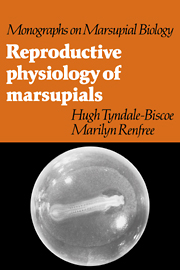Book contents
- Frontmatter
- Contents
- Preface
- 1 Historical introduction
- 2 Breeding biology of marsupials by family
- 3 Sexual differentiation and development
- 4 Male anatomy and spermatogenesis
- 5 The female urogenital tract and oogenesis
- 6 Ovarian function and control
- 7 Pregnancy and parturition
- 8 Lactation
- 9 Neuroendocrine control of seasonal breeding
- 10 Marsupials and the evolution of mammalian reproduction
- References
- Index
10 - Marsupials and the evolution of mammalian reproduction
Published online by Cambridge University Press: 06 January 2010
- Frontmatter
- Contents
- Preface
- 1 Historical introduction
- 2 Breeding biology of marsupials by family
- 3 Sexual differentiation and development
- 4 Male anatomy and spermatogenesis
- 5 The female urogenital tract and oogenesis
- 6 Ovarian function and control
- 7 Pregnancy and parturition
- 8 Lactation
- 9 Neuroendocrine control of seasonal breeding
- 10 Marsupials and the evolution of mammalian reproduction
- References
- Index
Summary
All discussions about the origin and evolution of mammalian reproduction are constrained by the time frame of the fossil record and rely to a considerable extent on comparisons between the modes of reproduction in living representatives of the Prototheria (monotremes), Metatheria (marsupials) and Eutheria (placentals). Such comparisons are limited by the degree to which the processes of reproduction are understood in each group and by the assumption that the living species resemble their remote ancestors in essential features. In comparing living mammals there is now little dissension from the view that the Monotremata share fewer characters in common with the Metatheria than the Metatheria do with the Eutheria. This applies to characters controlled by structural genes, such as serum proteins (Kirsch, 1977a), amino acid sequence of haemoglobin and myoglobin (Whittaker & Thompson, 1974), chromosome number and sex-determining mechanisms (VandeBerg et al., 1983) which probably reveal true evolutionary affinities, as well as anatomy and reproduction (Griffiths, 1978). Where the differences of opinion occur are in how the living mammals are to be related to Mesozoic mammals and what evolutionary lines are to be drawn therefrom.
Discussion of evolutionary relationships has been enhanced by the theory of cladism but the power of cladistic analysis is only as great as the knowledge of the character states available. For fossils these are necessarily the characters controlled by regulatory genes which produce phenotypic changes in response to local environmental demands, and are limited to teeth, bones and the impressions of other organs left on them, and may be of little evolutionary significance in the cladogram, a point raised by Kemp (1983). Nevertheless, fossils provide the essential time frame for any evolutionary hypothesis.
- Type
- Chapter
- Information
- Reproductive Physiology of Marsupials , pp. 396 - 423Publisher: Cambridge University PressPrint publication year: 1987
- 2
- Cited by



